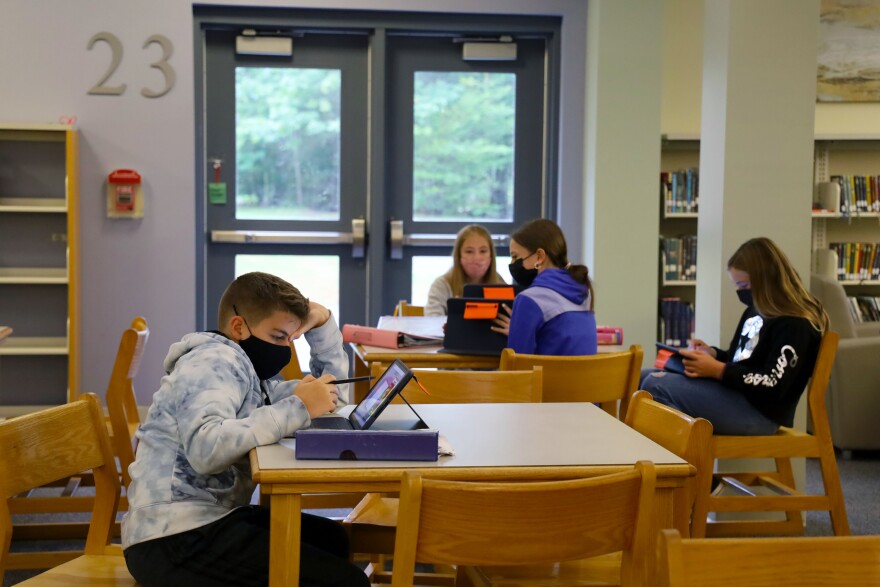Last year, Maine public schools saw enrollment fall by about 8,000 students, or 4%. It was one of the largest declines in the country, and came as many families homeschooled their children in the midst of the pandemic. A year later, some students have returned, but enrollment numbers remain well below their pre-pandemic levels. For more on what this all means, reporter Robbie Feinberg spoke to All Things Considered Host Jennifer Mitchell.
Note: This reporter debrief has been lightly edited for clarity.
Jennifer Mitchell: So, can you take us through the latest numbers from the state? What do they tell us?
Robbie Feinberg: Well, to start, let's remember last year's numbers, which showed declines in Maineand across the country. As you point out, public school enrollment fell in the state by about 8,000 students. This year, those numbers rebounded — but just barely. We went from about 172,474 public school students in Maine last year, to 173,158 students this fall. That's an increase of less than half a percent. And it's still about 7,000 students fewer than before the pandemic.
So those numbers don't sound ideal. Is there anywhere where the news is better?
A state Department of Education spokesperson noted that some rural areas have seen relatively large increases in public school student numbers over the past few years. That includes several schools in the Midcoast, close to Damariscotta, as well as a few schools north of Bangor, plus some near the mountains of northern Franklin County.
Enrollment in public Pre-K and Kindergarten also rebounded quite a bit this fall. The numbers still aren't quite back to where they were before the pandemic began, but they're substantially higher. However, if you look at some of the older grades, many of those enrollment numbers actually fell again this fall, so that could be a worrying sign.
Overall do we have any sense why enrollment hasn't rebounded to what it was before the pandemic?
None of the experts or officials I talked with had any one good answer to this question. There are a few likely factors: in general, school enrollment has been falling in Maine over the past few decades. And more Maine families are continuing to homeschool their children. According to state data, about 5,000 more children were homeschooled in the state last year, as compared to before the pandemic. Some of those students headed back to a public school this fall, but many stayed home, likely accounting for some of the continued enrollment drop. School officials also wonder if the fact that the beginning of the school year lined up with another wave of COVID-19 cases may have led some families to keep students at home, too.
Eileen King, the deputy executive director of the Maine School Management Association, also speculated that some students may have been lost from the system. Families may have just up-and-moved from one town or state to another without alerting their home districts. And she says that may be impacting enrollment, too.
"They've got guidance counselors and social workers that are doing everything they can to find out what has happened to some of the families," King said. "Some, they find out, have moved out of state, and have not enrolled. So they're just trying to track these kids down"
King noted that this is still speculative at this point, though, so we can't know for sure what's causing this.
School enrollment is also important for how much money districts receive from the state each year. So how could this latest trend impact that?
This is a real concern for schools and other education experts. That's because in addition to the meager enrollment growth, some communities are also reporting higher property valuations, which could influence how much money schools receive. Plus, the state is now offering universal school meals, and school officials worry that could lead to fewer families filling out free-and-reduced price lunch forms. Those forms also help determine how much federal money schools receive, so they're concerned that fewer forms could mean less federal money, too.
Obviously, a lot of this is still hypothetical at this point. And these latest numbers are based on just a few years of data. But Bates College Professor Mara Tieken says that if the trends continue, it could make it harder for public schools to operate, particularly in small, rural towns.
"I think schools are such an important public resource. And when we turn away from them, we lose that sort of public benefit," Tieken said.
Tieken hopes that the trends may reverse themselves when the pandemic and health become less of a concern — though no one can say when that will happen.
Has the state said anything about what they're doing to address the issue?
The state Department of Education and the legislature took several steps last year around school funding, including tweaking the state's school funding formula to lessen the impact of some of these enrollment declines.
Districts say that did make a difference. Plus, it came on top of a lot more funding. The federal government has spent billions more on schools over the past year — plus, and Gov. Janet Mills added $180 million in education funding to the state's biennial budget, which helped a lot of districts to maintain services and reduce the property tax burden.
We'll likely get a better sense of what funding could look like in early January. That's when the Maine Department of Education says it will send out initial funding estimates to schools.



